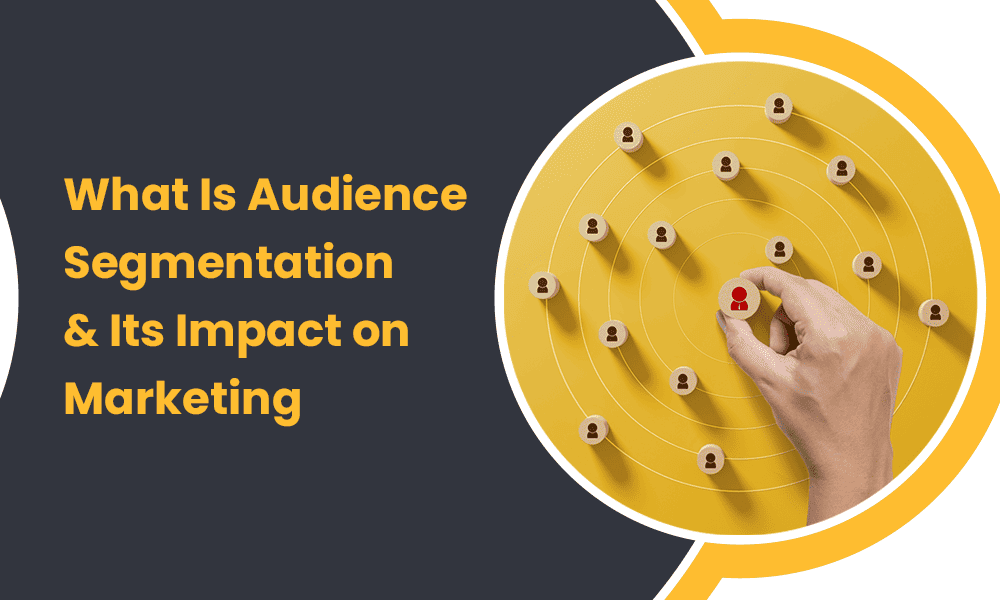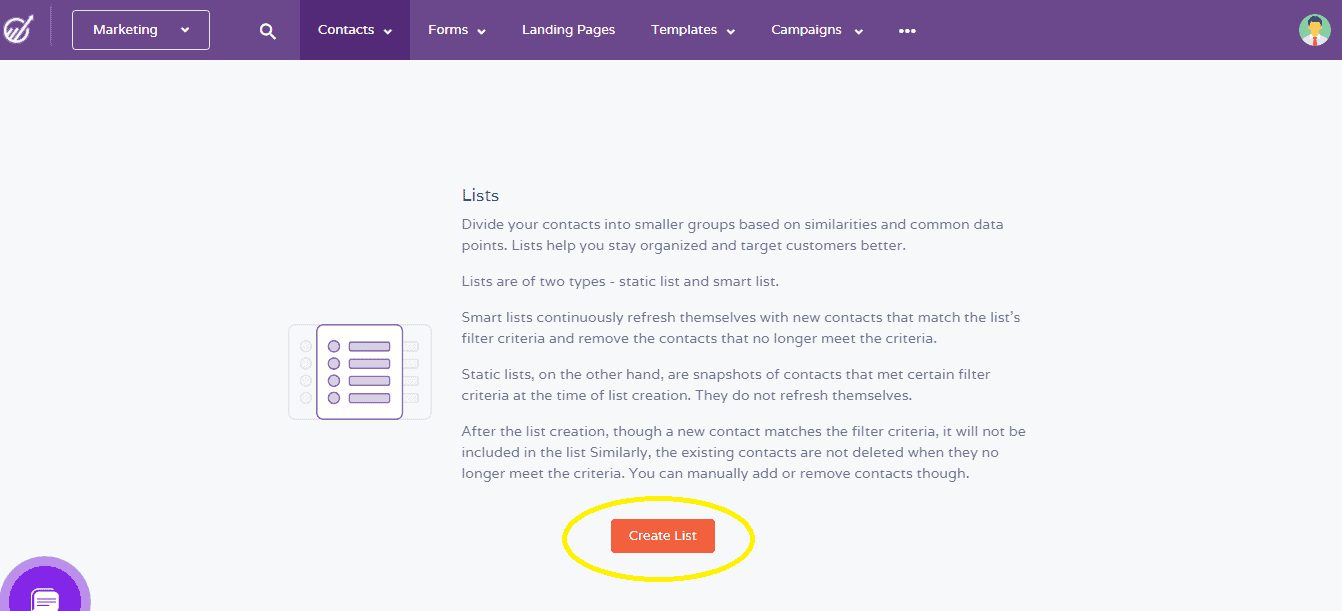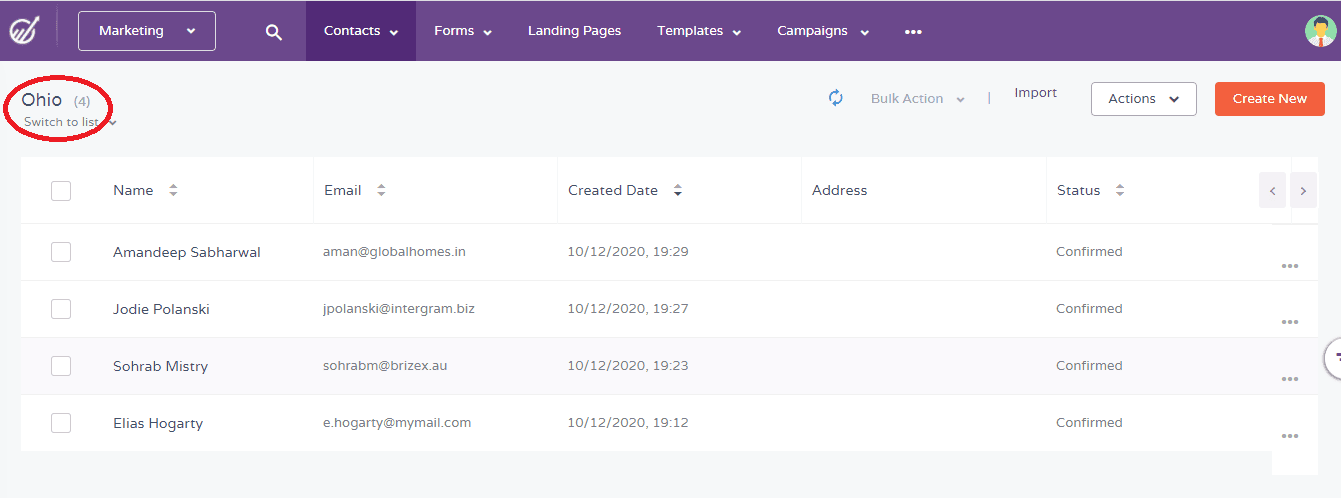You may have heard of the term ‘audience segmentation‘, but do you truly understand what audience segmentation entails?
Your audience is a diverse group of individuals scattered across the globe, engaged in various occupations, and possessing distinct needs, interests, and pain points.
As a marketer, while it may be tempting to try and appeal to every single customer in a uniform manner, a one-size-fits-all approach often falls short of delivering the desired results.
Instead, a much smarter marketing strategy is to segment your audience into different buckets or groups based on relevant characteristics.
You’ve likely heard about the concept of audience segmentation before, but perhaps you’re unsure about the practical implementation.
However, audience segmentation is not only a buzzword; it is a crucial practice that can significantly impact your marketing efforts in a positive way.
In this article, we will delve deep into the topic of audience segmentation, providing a comprehensive understanding of what it entails.
We will explore the different types of audience segmentation, explain why it is essential, and guide you on how to execute it effectively.
By dividing your audience into distinct segments, you can create targeted and personalized marketing strategies that resonate with specific groups, yielding remarkable results.
Through audience segmentation, you gain a profound understanding of your customers, enabling you to tailor your messaging, product offerings, and marketing channels to better meet their needs.
By doing so, you can enhance customer engagement, drive conversions, and build long-lasting relationships with your target audience.
So, let’s embark on this journey of audience segmentation, where we will uncover its benefits, explore various audience segmentation approaches, and highlight the transformative outcomes you can achieve by strategically dividing your audience into meaningful segments of your target audience.
Audience segmentation is anything but a waste of time.
In this article, we’ll dive deep into the topic, explaining audience segmentation, the types, why you should do it, and how to do it.
We’ll also let you know the kinds of results you can achieve by splitting up your audience into different segments.
Table of Contents
What Is an Audience Segment?
Before we get too far this article, let’s define customer segments first.
Customer segments are simply smaller portions of your bigger audience. You can segment your audience based on just about any criteria, as you’ll see in the next section.
Sometimes, these segmentation criteria stay static, and other times, they change. You can even put a group of customers into more than one target audience segment if they fit the bill.
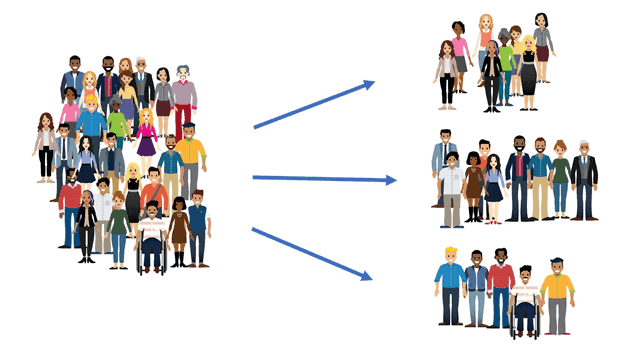
Image courtesy of Trailhead
Audience segmentation also goes by the name buckets. It’s the same concept, just another term. We’ll use both throughout this article. Below are a couple of audience segmentation examples for better understanding.
In this example of what it means to segment your audience, let’s say it’s the birthday of someone at your small business. You decide to bake a cake.
Half the office likes chocolate cake and another big chunk likes vanilla cake. A smaller portion prefers a different type of cake entirely, like maybe strawberry, caramel, or pineapple upside-down cake.
Yet another portion of your audience doesn’t even like cake and would rather have pie or cheesecake.
Knowing that, what would happen if you made a chocolate cake anyway? Most of your coworkers would eat it, but not all. Those who prefer vanilla, other flavors, or other desserts might refrain from having a slice.
What if you made a vanilla cake instead of chocolate? Now all the chocolate lovers, or half the office, would skip the cake. That’s a pretty big group of people.
For a quick example, you segmented your coworkers based on the flavors of cake they like. You know that making one type of cake won’t make everyone happy.
Three smaller cakes and maybe a pie would appeal to the whole office.
It works the same in marketing. If you’re selling a product or service, you can’t expect everyone to care about it.
For some, it’s just not something they’re interested in. Others will have no use for the product. More still might find it too expensive.
By dividing your segments based on criteria like pain points, interests, and income, you can then change your marketing approach.
For those customers who don’t need it or aren’t interested in your product, you’d find an alternate product they’d enjoy more.
The customers who can’t afford your new product would get an email for a cheaper secondary product.
That’s audience segmentation in a nutshell.
The Types of Segmentation
- #1 Demographic
- #2 Behavioral
- #3 Psychographic
- #4 Firmographic
Remember how in the last section we said you could segment your audience using just about any criteria? It’s true! Here’s a list of the various types of audience segmentation.
#1 Demographic
Let’s start with the most basic audience segmentation type, demographics. If you’re a clothing retailer, you wouldn’t send your female audience members an email for men’s clothes, right? The same applies vice-versa.
Gender is just one type of demographic segmentation. The others include:
- Age
- Education level
- Occupation
- Job title
- Income
- Ethnicity
- Marital status
- Family size
- Religion
- Race
Now, we know what you’re thinking. Isn’t some of that information…invasive? Why do you need to know a customer’s religion? You don’t, not necessarily.
While it may seem like you’re requesting other sensitive info, like income, you need this for the best marketing approach.
Just look at the example we shared in the last section. If you don’t know how much money your customers make, then you might accidentally market a product to them that’s too expensive.
While you don’t have to be privy to the amount of money they bring in down to the very last dollar and cent, a ballpark estimate benefits you well.
#2 Behavioral
The next type of audience segmentation in marketing is behavioral segmentation. With behavioral segmentation, you focus on a customer’s buying and shopping behaviors. This doesn’t necessarily relate to how they’ve behaved around you, but maybe the competition.
When tracking a customer’s behavior, you might study:
- Which technology they use and how often they use it
- The companies and brands they favor
- The type of products they spend their money on
- How often they shop
You can then use this handy information to tailor your approach to your target audience on the basis of this behavioral segmentation so it’s more personalized.
If you know they do a lot of research before pulling the trigger on a purchase, for instance, then you might send educational, informative emails earlier to aide them in their research.
You may also hold off on your product offer, making it later than you usually do so the target customer based is likelier to bite.
#3 Psychographic
Moving onto psychographic audience segmentation, with this, you’re focusing more on the lifestyle or values of your audience members.
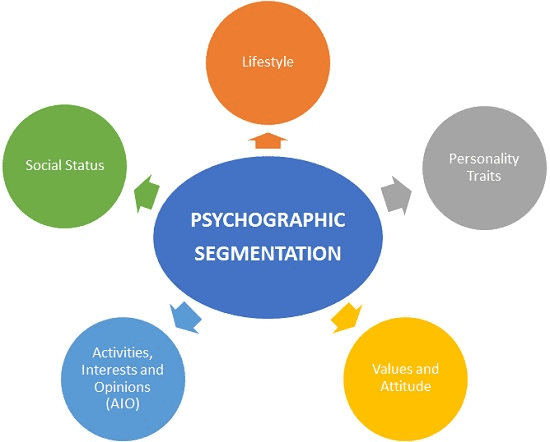
Image courtesy of MBA Skool
For instance, you might look into:
- Customer loyalty
- Social media status based on information like age, occupation, and income
- Hobbies and interests
- Attitudes and opinions about cultural matters, the arts, recreation, sports, the environment, politics, and religion
- Personality traits
Again, some of this is dicey territory to enter, but it allows you to do your job as a marketer better.
#4 Firmographic
You may also choose to segment your audience based on firmographic data. In a business-to-business or B2B application, you might home in on firmographics like:
- The location of a company
- The size of the company
- The revenue of the company
- The company’s industry or field
- The sales cycle stage of the company
Read also: Behavioral Targeting: The Future of Digital Marketing
The Importance of Audience Segmentation
- A Personalized, Individualized Feel = Better Chance of Buying
- More Customer Loyalty Across the Consumer life-cycle
- Bringing in New Customers
- More Sales at Different Price Tiers (and Upselling)
- Happier Customers
Okay, so you’re quite familiar at this point about what an audience segment is as well as the types, but why is it at all significant?
We’re glad you asked! If the following factors matter to the short or long-term goals of your company at all, then you’ll soon understand the very importance of segmenting your audience.
A Personalized, Individualized Feel = Better Chance of Buying
Customer personalization is more than just the big buzzword of the day.
In a world where company transparency has become a beloved business trait, customers want to feel like an individual to a company, not just another number.
By targeting the content and the offers you send to your customers, you’re adding to that personalization. You should still continue to use other personalization tactics as we’ve covered on this blog, but add targeted offers on top of that.
According to 2015 data from SocialTime, when customers receive a targeted, personalized offer, they’re probably going to take it, with a 78-percent likelihood of that happening.
More Customer Loyalty Across the Consumer life-cycle
When your customers know they can count on you to provide them relevant content and product offers, again and again, they begin to foster a sense of loyalty towards you. They know you’re not simply in it to make a quick buck, but to build a targeted audience base of long-term customers.
Bringing in New Customers
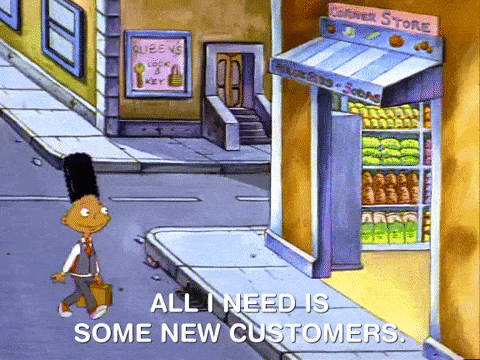
Selling one ol’ blanket product to your whole audience doesn’t fly, as we’ve already discussed in detail. What do you do if you’ve identified an audience segment but you don’t have any relevant products or services for them?
You might create niche products that appeal to the needs and interests of this audience base. The more niche products your company introduces, the more you might notice a pleasant side effect.
Others outside of your target audience may catch onto the niche products, becoming customers themselves.
More Sales at Different Price Tiers (and Upselling)
These niche products might have different price tiers to appeal to the various segments of your audience.
After all, you did your research and discovered that there’s an income fluctuation among your segments. Some parts of your audience make a lot more money than others, but you want to sell to them all.
By introducing pricing at different tiers, you’re not excluding any parts of your audience. Even the lower-income members get a chance to buy if they’re so inclined.
You might think you’re making less money this way, but consistent sales at lower price points beat out spotty sales at higher price points in most instances.
Besides, you could always try upselling to some segments. With upselling, you offer them more related products or accessories at a higher price.
Just think of the classic example of supersizing your burger and fries to an XL burger, large fries, and a jumbo drink.
Happier Customers
Customers who feel understood and like you care about their needs and interests will happily tell their friends and family about your level of service.
This too could attract new customers or at least keep your current ones sticking around.
Always make sure you’re bringing in new prospects with lead generation to keep the process moving!
Divide your contacts into smaller groups based on similarities and common data points. Lists help you stay organized and target customers better.
Read also: A Comprehensive Guide To eCommerce Email Segmentation
How to Segment Your Audience
- Step #1 Survey Your Audience
- Step #2 Determine Who Fits Your Target Market
- Step #3 Make Profiles for Each Identified Segment
- Step #4 Review Each Segment
- Step #5 Handpick Your Content and Offers and Send These Out
- Step #6 Use Analytics to Track Results
With the benefits laid out in the prior section, it’s time to discuss the steps you should take to segment your very own audience.
Survey Your Audience
Whether you mail out your surveys or ask your audience to fill out a form online, the only way to learn more about your customers is through the information they volunteer to you.

To incentivize them to complete a longer survey, you might offer these participants a discount or freebie.
Determine Who Fits Your Target Market
Who is your target market? These people have the highest chance of buying from you, so of course, you want to market towards them. To find them, you’d do market segmentation, dividing your current audience by behavior, psychographics, firmographics, and demographics as mentioned earlier.
Make Profiles for Each Identified Segment
To keep track of all the segments you created, we recommend you create profiles for each of them.
Review Each Segment
Next, it’s time to do some dirty work. Study each of your segments to determine which may have the highest receptivity to your offers.
You don’t necessarily want to refrain from working with those less viable segments, but set them aside for now. You’ll have to come up with an even more ultra-targeted approach for them later.
Read also: Uncovering Insights with Behavioral Market Segmentation
Handpick Your Content and Offers and Send These Out
With your most viable segments identified, it’s time to reach out to them. Make sure you curate the content and later, the offers you send so they appeal to each segment.
This increases your chances of customer retention as well as making the sale.
Use Analytics to Track Results
Segmenting your audience isn’t perfect art. You may have mis-segmented some people, which shows in your lower sales or engagement.
For each segmented campaign, you launch, make sure you load up your analytics software to see how well you did.
Did the audience segments open your emails and respond to them? Did they visit your website and shop?
For those segments that didn’t respond as well, you have to ask yourself why. Could it be you didn’t present offers that were targeted enough? Did other factors stand in your way? That’s up to you to decide.
Here’s a graph outlining the steps we just covered.
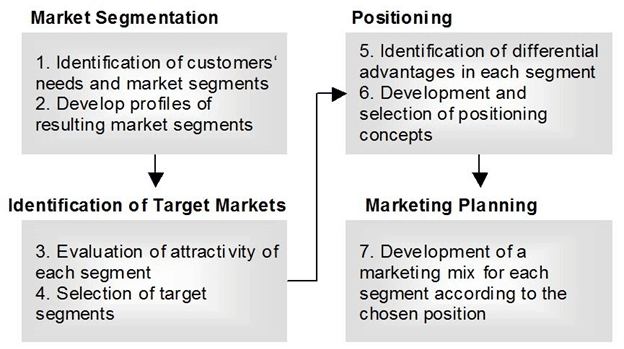
Image courtesy of TheManager.org
Read also: Customer Segmentation Examples & How To Follow Them
The Pros and Cons of Audience Segmentation
- You Must Have a Concrete Understanding of the Needs of Each Segment
- You Can’t Miss Any Audience Segments
- Audience Segmentation Isn’t Fast or Cheap
We already discussed the many advantages of segmenting your audience. You can obtain more customers, increase sales, boost customer engagement, and watch as the loyalty of your customers goes way up.
What about the downsides? Do they even exist? Indeed, they do. To remain as fair and balanced as possible, let’s discuss the cons of dividing your audience into buckets.
You Must Have a Concrete Understanding of the Needs of Each Segment
Assuming you have all the information you do about your audience segments, messing up could really hurt your company’s reputation. You must double-check, even triple-check that the needs and pain points you came up with for each audience segment actually align with those real-life needs.
You Can’t Miss Any Audience Segments
Sometimes, it’s so easy to get caught up in marketing to one seemingly difficult or elusive segment that you forget about who’s right in front of you.
Purposely or accidentally missing certain audience segments can hurt both sales and customer loyalty. You don’t want either.
Audience Segmentation Isn’t Fast or Cheap
While we made segmenting your audience sound easy in the last section, in reality, it’s a job that takes a while.
You’ll also often end up spending a lot of money on market research, customer relationship forms and surveys, and the segmenting itself.
Even once you finish your initial round of audience segmentation, people change. They leave jobs, get married, start a family, change careers, or retire.
You’d have to switch these audience members across various segments, which often means pretty much going through the whole process all over again.
Create a segment based on demographics such as age, location, etc. or interests, or any other common characteristics
The Impact of Audience Segmentation on Marketing
As we’ve explained across the entirety of this article, audience segmentation can make or break your marketing campaign in several ways to segment a market. Here’s a recap.
Personalizing your offers and other communications increases the chances of the customer taking the bait if you recall the stat from before.
Also, marketing resource ZoomInfo says that consumers have a higher chance (75 percent) of shopping with a company that knows their name and purchase history.
Financial company Fundera says most of an average company’s revenue (65 percent) is built off the purchasing loyalty of repeat customers.
Since audience segmentation strategy can help you build those happy, loyal customers, we’d say it’s quite impactful.
You’ll also see more sales and possibly even new customers by targeting the offers you send to your audience.
While it’s not the easiest nor the cheapest process ever, if you haven’t done it yet, you’re doing yourself a disservice.
After all, in a 2012 article, Content Marketing Institute said “content fed to all audiences serves too many masters.”
We couldn’t agree more.
Email marketers who segmented their audience before campaigning stated that the revenue generated increased to up to 760%. Targeted and segmented emails bring in 58% of all revenue. (NotifyVisitors)
Read also: What is Behavioral Targeting? [Challenges and Examples]
Conclusion
Audience segmentation is a complex process that involves categorizing individuals into various segments based on a wide range of information and data.
This can encompass demographics such as age or gender, firmographics like company size, psychographics that delve into personality traits and interests, or behavioral data that tracks shopping frequency and patterns.
By gathering and analyzing this valuable information, you gain insights that enable you to tailor your marketing efforts to specific audience segments.
Once armed with a deep understanding of your audience segments, you can create customized offers and experiences that resonate with their unique characteristics and preferences.
This personalization fosters a sense of customer loyalty, as individuals feel seen and understood by your brand. Moreover, targeted marketing efforts are more likely to yield higher conversion rates, resulting in increased sales and revenue.
with effective audience segmentation, you can not only retain existing customers but also attract new ones who find your tailored offerings compelling.
Admittedly, segmenting your audience is not an easy or instantaneous task. It requires significant effort, time, and financial investment. However, the returns on this investment are substantial.
The benefits of audience segmentation extend far beyond the initial costs. By delivering personalized experiences, you can create a competitive edge in the market, foster brand advocacy, and enhance customer satisfaction.
Additionally, segment-specific marketing campaigns allow you to allocate resources more efficiently, focusing on the segments that offer the greatest potential for growth and profitability.
In conclusion, while audience segmentation may involve a considerable investment, the benefits of audience segmentation far outweigh the costs. By understanding your audience on a granular level and tailoring your outreach efforts accordingly, you can forge stronger connections, increase sales, attract new customers, and boost customer retention.
Embracing audience segmentation as a strategic business practice is a worthwhile endeavor that will propel your company towards sustainable growth and success. So, allocate the necessary resources and embark on this journey of personalized marketing that will yield substantial returns in the long run.

